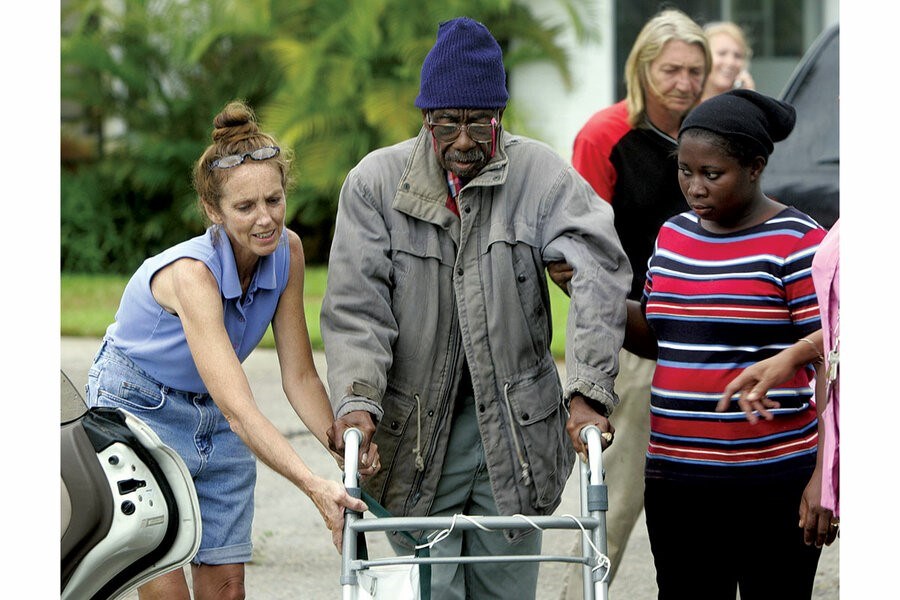REPRINTED WITH PERMISSION FROM THE CHRISTIAN SCIENCE MONITOR
 Two employees help a retirement center resident evacuate in Boynton Beach, Florida, as the storm that became Hurricane Katrina nears the state on Aug. 25, 2005.J. Pat Carter/AP/File
Two employees help a retirement center resident evacuate in Boynton Beach, Florida, as the storm that became Hurricane Katrina nears the state on Aug. 25, 2005.J. Pat Carter/AP/File
January 30, 2023
When a natural disaster occurs, safety can hinge on moving people quickly. That becomes especially complicated when people have mobility issues or other disabilities.
The challenge is gaining relevance as global temperatures rise and extreme weather events like floods and heat waves grow more severe. In many parts of the world, residents and governments are not fully ready for this “acceleration and multiplication of threats,” says Sébastien Jodoin, founding director of the Disability-Inclusive Climate Action Research Program at McGill University in Montreal.
When it comes to preparedness and disaster response, poorly designed and inaccessible policies can exacerbate social inequities, leaving some of the most vulnerable people to fend for themselves. Inclusive policies, on the other hand, can save lives.
What accessibility barriers exist in current disaster risk plans?
In 2005 during Hurricane Katrina in Louisiana, people with disabilities died at a rate 2 to 4 times higher than others, largely because of the inaccessibility of transportation, shelter, evacuation, and rescue. One Katrina survivor, diagnosed with an illness that affects her mobility, recounted to The Associated Press how she relied on assistance from co-workers to climb two flights of stairs to safety as water levels rose.
“We see that kind of story being repeated all over the world and across different events,” Dr. Jodoin says.
The problem: Nations are making plans for adaptation or disaster response, but often forgetting the particular needs of people with disabilities. One reason may be ignorance.
“Many people don’t have the understanding that people with disabilities experience climate change very differently – much more intense – than other people and the coping mechanisms or strategies are much more limited for them,” says Elham Youssefian, senior adviser for inclusive humanitarian action at the International Disability Alliance.
What are the benefits of disability-inclusive climate policy?
The most obvious beneficiaries are people with disabilities. But Dr. Jodoin, who has been diagnosed with multiple sclerosis, points to the so-called curb-cut effect as evidence that accessible planning can be broadly beneficial. While sidewalk ramps were designed for people with disabilities, the curb cuts also benefit kids on bikes, parents with strollers, and delivery workers.
Greater accessibility makes it possible for more people to use public services – and the same logic can be applied to climate adaptation. “The more ways you have for evacuating people in an accessible way, the more lives you’ll save,” he says. “When we have these inclusive climate solutions, there’s more people who benefit and whose lives are saved and who can also be part of a transition to carbon neutrality.”
What steps are being taken worldwide?
Almost all countries (but not the United States) have ratified the United Nations Convention on the Rights of Persons with Disabilities adopted in 2006, which calls on governments to safeguard the rights of people with disabilities, including their right to life in emergencies. Moreover, signatory countries to the 2015 Paris Agreement (the U.S. among them) agreed to respect human rights when acting on climate change, including the rights of people with disabilities.
Turning promises into action has been slow during three decades of U.N. Conference of the Parties (or COP) meetings on climate change. However, Dr. Youssefian applauds a “huge achievement” at the 2022 conference, which she attended: The work plan for the Action on Climate Empowerment now officially mandates the inclusion of people with disabilities.
Dr. Youssefian says she hopes this will prompt governments to act, and also diversify the ranks of people seen as agents of change.
“We, as persons with disabilities, really want to be part of the solution,” she emphasizes. “Persons with disabilities are 15% of the world population. So it’s a huge loss if we do not provide the opportunity for these 15% to help save the planet that we love.”
Page created on 2/6/2023 10:46:17 PM
Last edited 2/7/2023 12:45:48 PM
